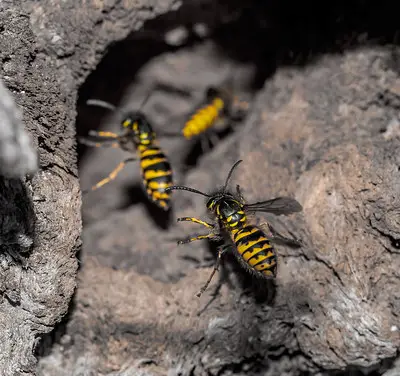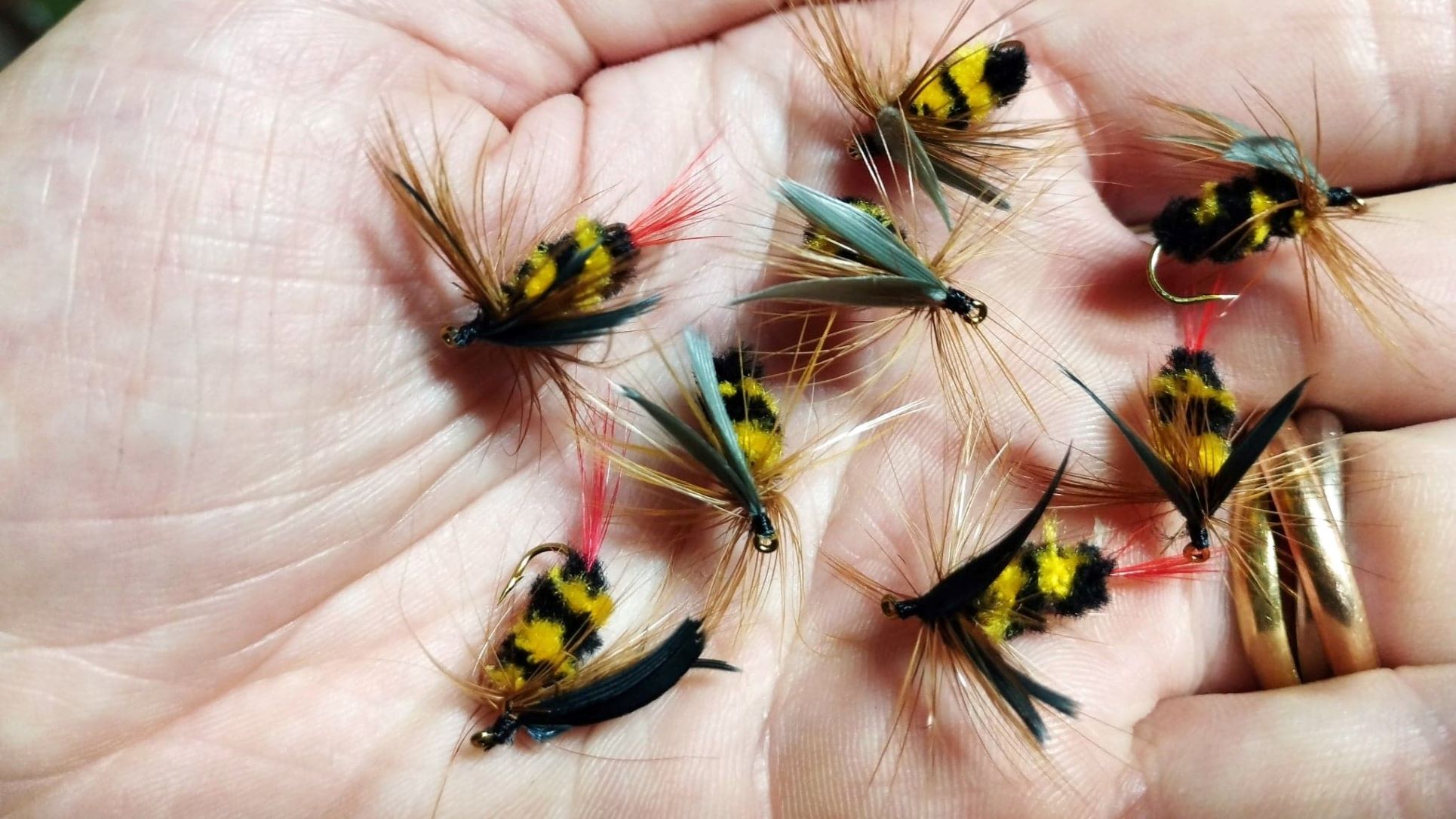If you look at any suggested fly list, or best fly list the bee pattern will never be on them. But they are a surprisingly common pattern. Often found fulling the fly boxes of fishermen new to the sport.
Their coloration also makes them very eye catching, I suspect they do a good job at catching fishermen.
In this article, I will take a look at the bee fly, and will attempt to answer the questions why are bee patterns so common, and will discuss if they are actually any good?
What are bee flies?
Bee flies are a medium size terrestrial dry fly pattern. They usually offer good buoyancy and are designed to be fished on the surface.
The black and yellow coloration makes them highly visible. Due to the brightness of the yellow bee patterns do work quite well as an indicator fly. Potentially a good offer to fish with a hopper dropper rig.
Bee flies come in many sizes, sharps, and forms.
As the name says, they represent bees, but also wasps, bumblebees, hornets, and yellow jackets. I group all these similar flies together as bee flies.
Why are bee flies so common?
Bee flies are very common because they seem to be a mainstay of budget bulk fly packs.
Many new fishermen who purchase such bulk packs will quickly find themselves with quite a selection of such patterns.
I do not know why discount fly companies love to include so many bee patterns I can only assume with their yellow and black swipes they are quite eye catching.
The more skeptical side of me, suspects that bee patterns are slow sellers so they full bulk packs with them to get rid of excess stock.

Are Bee flies any good?
I use to use the only bee pattern in my box to clean the eye of other flies. I have never thought highly of the pattern.
A few months back, I was testing a bulk pack of discount flies. I wanted to see just how terrible the cheapest flies I could find were.
The flies themselves were decent enough, not good but not terrible. I showed the box to a mate of mine who has spent a lot of time fishing the mountain parks of colorado, and he pointed to the rows of bees and volunteered that he had never caught a trout on a bee fly.
His feedback matched my experience entirely. Despite fishing with them a fair few times, I have never caught a trout on a bee pattern and I can not say I have seen anyone else fish with them.
I always thought bee flies should work well late summer into the fall when I see lot of drowned bees and wasps, but despite a reasonable amount of effort, I have not even gotten a trout to inspect them.
At the same time, my local trout the trout were also ignoring the real bees which were buzzing around or laying drowned on the surface. So in my personal experience, trout have to be rather desperate to eat a bee or wasp.
Searching online and asking around I have come across many arguments both in support and against the effectiveness of Bee flies. They do seem like a rather polarizing pattern. It sounds like, that under some circumstances trout do feed upon bees, and will readily take a bee fly. Some anglers do consider them quite highly.
In the fall, I have certainly seen photos of trout full of yellow jackets so trout certainly predate on wasps and bees when the conditions are right.
In my case, I might subconsciously only fish bee flies when nothing else is working.
When the trout are not taking my favorite patterns, I start to experiment and dig deeper into my fly box and these are the occasions I am most likely to try a bee pattern.
If the fishing is easy, I normally just stick with my favorites so probably have never given bee flies a fair chance.
When is best to fish bee flies?
Bee flies should work best when the bees are the most active. This is usually late summer into the fall. This also happens to be the best time to fish most flies based around large terrestrial insects.
I have also noticed, that during periods of low rainfall. Bees and wasps often fly to nearby water sources to get water. Sometimes I see hundreds, if not thousands of bees right on the water edge.
So it is not surprising that a few of these bees end up in the water where they quickly become stuck.
Other flies which look like bees
There are actually some very famous flies such as the Tellico Nymph that resemble bees.
I do not know exactly what the Tellico Nymph is supposed to represent, it could be a caddis larva, mayfly nymph or even a stonefly nymph. But in many ways, it resembles a small drowned bee.
Nevertheless, the Tellico nymph certainly catches its shares of trout and is certainly a popular fly in its birthplace of North Tennessee.
Another fly that resembles a bee is the McGinty. The McGinty is a traditional pattern, invented sometime prior to the 1940’s.
Like many traditional wet flies, I have honestly never fished a McGinty, I also have little idea what the McGinty is meant to represent. It is widely considered to be a bumblebee, but it is a wet fly that is meant to be fished submerged. This seems counterintuitive to me, I always fish bee patterns as dries. Whatever the case, the Mcginty does seem to be a productive pattern in the late summer. The coloration does not seem to be a deterrent.
How to tie a bee fly?
I do not tie my own bee flies, I always have more than enough in my boxes, but there are many tying videos on youtube. I decided to attach a couple of videos below that shows how to tie a bee pattern.
Killer bee pattern
Bumblebee pattern
Are trout scared of Bees, do the yellow and black put them off?
I do not believe trout are scared of bright colors. While I typically favor more subdue and natural colors when selecting flies. I have caught countless trout on brightly colored spinners. Including a bright yellow panther martin with black dots.
There are also many brightly colored wet flies and streamers. I personally do not fish them, but many are classic patterns that have been catching trout for generations.
So to put things simply. I doubt certain colors scare trout. Although trout can favor one color over another at times.

